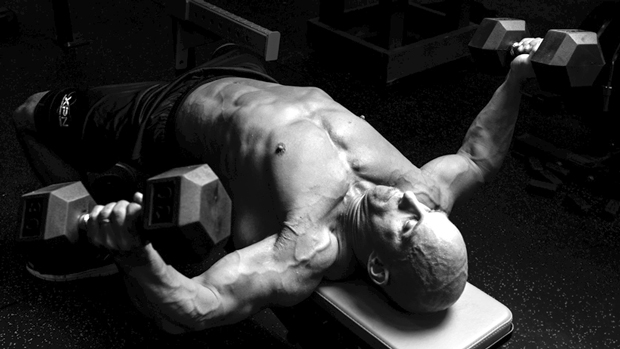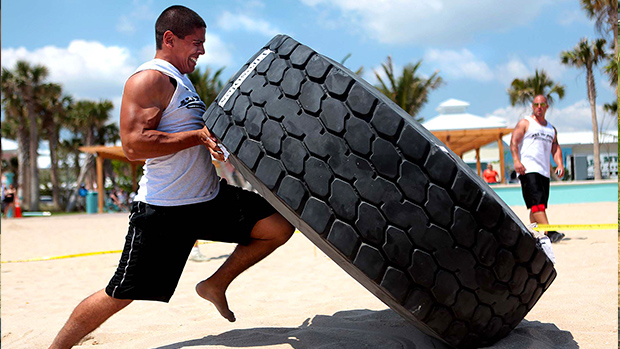Part 1 – Nonstop Natural Gains: The Neuro Typing System
Part 2 – Unlock Natural Gains: Neuro Type 1
Part 3 – Double Your Natural Gains: Neuro Type 2
Part 4 – Never-Ending Natural Gains: Neuro Type 3
Part 5 – The Neuro Type Workouts
Part 1 of this series introduces you to neurological typing. In short, your baseline levels of three neurotransmitters (dopamine, serotonin and norepinephrine) strongly influence your personality and dictate your how you should train and eat for best results. Part 2 covers the first neuro profile: the novelty seeker. Part 3 covers Type 2: the reward-dependant profile.
Now let's look at the best training, nutrition, and supplement plan for Type 3, the type associated with low serotonin who doesn't like change, but loves to master a repetitive activity. "Technique geeks" fit this profile. In psychobiology, they're referred to as harm avoiders.
Optimal Training for Type 3
Type 3's can be held back by the fear of injury and they tend to be more sensitive to pain. If anxiety is too high, it can make them tighten up, especially in the flexor muscles (front delts, pecs, hip flexors, hamstrings, biceps, and abs) which can negatively affect lifting mechanics and make them more prone to injuries. Both of these elements – lifting anxiety and tightening up – can make them shut down when it's time to lift.
The key for workout preparation is to reduce the feeling of pain and convince them they can execute the desired exercises without risk. They also need to work on their para-sympathetic system more. Dr. John Rusin's dynamic warm-up is great for them. They need to emphasize steps 1 and 2 the most. They need to do more self-myofascial release work (foam rolling etc.) as well as mobility work.
Activation work isn't as important for them. If they do too much it might actually have a negative impact by making them more reactive to stress, increasing cortisol even more. So in Dr. Rusin's protocol they'd do a normal amount of step 5, but very little of the activation work in step 6. They can even skip it.
Basically, this type doesn't need to amp up prior to a session, and they shouldn't. This will increase anxiety, flexor tightness, and cortisol release during the workout.
When it comes to the big lift of the day, they need more practice sets than activation sets to feel secure in their technique. For them, I recommend using a technique called compensatory tension (CTT). You compensate the lack of load with an increase in muscle tension. The coaching cue here is "make a light weight feel heavy." You do that by creating as much tension as possible even against a lighter weight.
For example, when squatting:
- Screw your feet into the floor. Try to externally rotate the hips.
- Crush the bar as hard as you can.
- Squeeze your upper back.
- Contract your abs. Imagine you're about to get punched in the stomach.
After that, squat down while maintaining maximum tension. Keep flexing those muscles on the way up too. Make every rep as hard as possible.
Do 4-5 of these sets, gradually heavier, then move on to your work sets. On your work sets you still establish tension at the beginning, but now simply focus on using great technique, not on making each rep harder. A ramp-up would look like this:
Ramp-Up Sets:
- Set 0: bar x 10
- Set 1: 165 x 5
- Set 2: 195 x 5
- Set 3: 215 x 5
- Set 4: 235 x 5
- Set 5: 255 x 5
- All of those sets are performed with a slow tempo and maximum tension.
Work Sets:
- Set 6: 275 x 5
- Set 7: 275 x 5
- Set 8: 275 x 5
- Set 9: 275 x 5
Type 3 lifters don't require a lot of training variety. In fact, variation itself can be a stressor. Also, if the training isn't what they expect, like the coach suddenly changes the routine or if they can't do the exercises as planned, it will take them out of the zone and might increase their anxiety, again raising cortisol.
The actual exercises should stay the same for a long time (up to 12 weeks), especially in the case of the big basic lifts. When variation is needed to prevent accommodation, it's best to go with what has the least impact on the feeling of novelty: rest intervals, tempo, exercise order, and set/rep scheme, in that order.
Other changes have to be done very gradually. Don't change everything at once. Start with assistance exercises requiring less complex skills and posing less of a threat.
This neuro type does better when the training schedule is stable – training on the same days at the same time.
Type 3's overproduce cortisol under stress... and a workout is a stressor. They also tend to get sore more easily, which is normal since a high level of cortisol makes you catabolic, decreasing the speed at which you can repair muscle damage.
They're not negatively affected by off days because they have a normal/high dopamine level. They can perform just as well after taking a few days off, contrary to the Type 1 profile.
The best frequency is 4 days per week using an upper/lower split. The optimal weekly schedule would be:
- Day 1: Lower body
- Day 2: Upper body
- Day 3: Off
- Day 4: Lower body
- Day 5: Off
- Day 6: Upper body
- Day 7: Off
Some might need even more rest days, going to a frequency of 3 sessions per week if they have a stressful life or a physical job. These two things will raise their baseline cortisol level. Too much training can actually prevent them from building muscle and getting leaner.
If they want a higher frequency of training – 5 days a week for example, which is high for them – they need to break down the body more, using less frequency per muscle group and including at least one "easy" workout in the week like an arm day or cardio/calves/abs day.
Remember, this neuro type tends to overproduce cortisol. The main function of cortisol during training is to mobilize stored energy. So the more volume they do, the more energy is needed and the more cortisol their bodies will pump out.
This is true for everyone, but in the case of Type 3's that cortisol response is magnified. On a side note, that might be one of the reasons they're good at endurance activities: they're efficient at mobilizing fuel.
For hypertrophy work they do better on a lower volume approach where a few work sets are taken close to technical failure but without going to the point where form breaks down. Two to 3 progressively harder warm-up sets and 1-2 work sets per exercise is best.
For strength/heavy work they do better on strength-skill – submaximal sets with 75-85% for 6 sets of 2-3 reps with a focus on technique – than on max effort workouts. The latter increases cortisol too much because of fear of injuries. Weight close to 90% or more will make them shut down because of an increase in anxiety.
They're really good at conditioning work because of their high dopamine to serotonin ratio, and because they don't get bored or run out of fuel due to the high cortisol release. But doing too much will kill their muscle gains much more so than other types.
Remember that a Type 3 personality can be de-motivated if they feel insecure when doing an exercise. So intensity zones that might be optimal on paper could lead to bad progression due to apprehension (conscious or not).
For hypertrophy, this neuro type does better on slightly higher reps, 8-15. For strength work they do better on sets of 4-6 reps when using the RM system and strength-skill. Specifically, they should use strength-skill work for the big lift of the session – 75-85% of 1RM for submaximal work of 2-3 reps, doing plenty of sets. They should use a low volume RM system – using the most weight they can for 4-6 reps done with perfect technique for 1-2 work sets, preceded by 2-3 gradually heavy warm-up sets.
A big motivation killer is feeling a movement in the joints, in the wrong place, or not feeling in perfect control. That's why with the big lifts they should focus on precision, perfect technique, and slower eccentrics (negatives).
Type 3 lifters respond better to changes in means, methods, and strategies rather than changes in exercises. Let's review the definition of these terms:
Means
Tools used when executing a movement pattern. Changing from a regular bar to a thick-grip bar is a change of means. Other examples: specialty bars, chains and bands, hanging band technique, weight releasers, dumbbells, kettlebells, cable system.
Methods
How the reps are performed. For example, changing the speed of the lifting or lowering portion of the rep, adding isometric pauses during one phase of the lift, partial reps, etc.
Strategies
How the sets are organized (sets x reps) and the use of intensifiers like drop sets and rest/pause.
The Type 3 athlete responds best to changes in strategies: changing work/rest ratio, varying loading schemes, or changing the exercise order.
Methods can also be changed but not as often and not on all exercises at the same time. Small changes like lifting tempo or adding isometric pauses should be the first choice, not intensification approaches like rest/pause, drop sets and the like.
Variations of means should be the least often used and reserved only for advanced individuals with solid technique mastery. This is especially true for chains, bands, hanging band technique, and weight releasers, which should rarely be used. Bar type can be changed, but less often than methods and strategies (maybe once per six weeks).
As for loading schemes, they do better on "sets across" – keeping the same number of reps with the same weight on all work sets.
When talking about exercise order we're only talking about the "building" work. Workout prep isn't included because proper workout prep is assumed.
This type has the capacity to perform well on the big lift even at the end of a workout. In fact, oftentimes they can even have a great performance while doing the big lift of the day at the end of the workout. They feel better, have less tension, are more prepared, and it removes some of their inhibitions and anxiety.
They can even do well on lifting exercises after having just done an endurance activity. For example, I had a female powerlifter hit her personal record on the deadlift shortly after doing cross-country skiing. I've also had CrossFit athletes hit a max snatch after a 5km run. (Of course, if someone is out of shape it changes things.)
Type 3's do better when the big lift of the day is placed later in the workout. At first their performance might drop off due to fatigue, but once they adapt to it they can perform really well with that setup.
This neuro type is overcautious when it comes to adding weight and can be unsettled by "not knowing." They don't need a lot of variation. They're detail-oriented and injuries are always in the back of their minds, so they tend to be conservative with load.
They do great on periodized programs where the weights are planned months in advance (5/3/1, 915, Sheiko) because these programs force them to add weight to the bar. And because they know a long time in advance when they'll have to increase the weight, it makes them more secure about going up in load. This helps remove their inhibition and perform better while also reducing the cortisol response.
Pre-planned programs give them security and peace of mind. As a result, they train harder. They do better when they have a precise task to do, like 5 sets of 4 at 80%. The more "unknown" the task (4-5 sets of 3-5 reps at 80-85%), the less secure they are and the harder it'll be to train hard. They need more specifics.
For phase to phase progression, they respond better to a model where you start with more volume and gradually increase intensity over time. Intensity (amount of weight used) represents a stress for them so they need to work toward it, gradually getting used to it.
- This neuro type needs a small amount of carbs in every meal to feel good when dieting. On excessively low carb diets they might feel depression-like symptoms because they have a low baseline level of serotonin. A low carb diet can lower serotonin even more which will make them lethargic, have an increased pain response, and a drop in motivation and willpower.
- They also need carbs because they overproduce cortisol. One of the functions of cortisol is to mobilize stored energy/glycogen, so the more glycogen you need to mobilize, the more cortisol you need to pump out. By providing carbs pre-workout, you reduce cortisol production during training.
- When cortisol is constantly elevated, T4 to T3 conversion is decreased, which can decrease metabolic rate. Remember, T4 is the inactive thyroid hormone while T3 is the thyroid hormone that plays a big role in metabolic rate and energy expenditure. Low T3 equals lowered metabolic rate, which makes it harder to lose fat. Furthermore, carbs are needed to maintain optimal T4 to T3 conversion. So by having these high cortisol types go low carb you could really slow down their fat loss by eventually decreasing T3 levels.
- While they should have a small amount of carbs at every main meal, there are two times where carbs are very important, especially when trying to build muscle. First is pre-workout since it will lower cortisol. Since they have low serotonin and high dopamine levels, pre-workout carbs like Surge® Workout Fuel will not decrease workout motivation and focus. Second is the last meal of the day where you want more carbs to increase serotonin when this type needs it most: at night to rest, decrease anxiety, and recover.
- The quantity of carbs ingested will depend on insulin sensitivity, body size, and activity level. A good starting point is about 1.25 grams per pound of body weight when trying to lean down, and 2 grams per pound of body weight when trying to build muscle. Adjust up and down depending on how your body is reacting.
- They do better on smaller calorie deficits done for a longer period of time. In other words, a diet of longer duration with only slightly lowered calories is best. They don't do well on extreme, short-term, more calorie-restricted diets.
- They don't need frequent refeeds. When they do refeed, it should be with healthy foods they're used to, not crap.
Next we'll dig deeper into workouts for each type and take a look at mixed neuro types.





